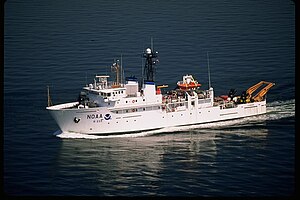USNS Titan
 NOAAS Ka'Imimoana (R 333), ex-USNS Titan (T-AGOS-15), sometime between 1996 and 2009.
| |
| History | |
|---|---|
| Name | USNS Titan (T-AGOS-15) |
| Namesake | A titan is something or someone of very large stature, greatness, or godliness |
| Operator | Military Sealift Command |
| Ordered | June 30, 1986 |
| Builder | VT Halter Marine, Inc., Moss Point, Mississippi |
| Laid down | October 30, 1986 |
| Launched | June 18, 1988 |
| Acquired | March 8, 1989 (delivered) |
| In service | March 8, 1989 |
| Out of service | August 31, 1993 |
| Stricken | August 31, 1993 |
| Fate | Transferred to National Oceanic and Atmospheric Administration, August 31, 1993 |
| Name | NOAAS Ka'imimoana (R 333) |
| Namesake | Ka'imimoana is a Hawaiian word meaning "Ocean Seeker" |
| Acquired | August 31, 1993 |
| Commissioned | April 25, 1996 |
| Decommissioned | June 18, 2014 |
| Homeport | Pearl Harbor, Hawaii |
| Identification |
|
| Status | Inactive in NOAA Pacific Fleet |
| General characteristics (as U.S. Navy ocean surveillance ship) | |
| Class and type | Stalwart class |
| Displacement | 2,250 tons (as built) |
| Length | 224 ft (68 m) |
| Beam | 43 ft (13 m) |
| Draft | 16.0 ft (4.9 m) |
| Propulsion | Diesel-electric, two shafts, 1,600 hp |
| Speed | 11 kt cruise |
| Crew | 36 |
| General characteristics (as NOAA oceanographic research ship) | |
| Class and type | ex-U.S. Navy Stalwart-class research ship |
| Tonnage | |
| Displacement |
|
| Length | 224 ft (68 m) |
| Beam | 43 ft (13 m) |
| Draft | 15 ft (4.6 m) |
| Installed power | 1,600 hp (1.2 MW) |
| Propulsion | bow thruster |
| Speed | 10.5 knots (19.4 km/h; 12.1 mph) (sustained) |
| Range | 8,000 nautical miles (15,000 km; 9,200 mi) |
| Endurance | 30 days |
| Boats & landing craft carried | One 22 ft (6.7 m) rigid-hulled inflatable boat (RHIB); one 17-foot (5.2-meter) inflatable utility boat |
| Complement | 20 (3 U.S. Public Health Service Health Programs Officer, 3 licensed engineers, and 13 other crew) plus up to 12 scientists |
| Sensors and processing systems | Deep-water radio direction finder, Sperry gyrocompass |
| Notes | Welded steel, ice-strengthened hull |
USNS Titan (T-AGOS-15) was a
Construction
The U.S. Navy ordered Titan from
On the day of her delivery, the U.S. Navy placed the ship in non-commissioned service in the
After the Cold War ended with the collapse of the Soviet Union in late December 1991, the requirement for SURTASS collection declined. The Navy took Titan out of service on August 31, 1993 and struck her from the Naval Vessel Register and transferred to the National Oceanic and Atmospheric Administration (NOAA) the same day.
National Oceanic and Atmospheric Administration service
Capabilities
Ka'imimoana has
Ka'imimoana has 950 sq ft (88 m2) of
Career
Ka'imimoana was home-ported at Pearl Harbor, Hawaii, and was the only NOAA ship dedicated solely to climate research. She supported NOAA's Tropical Atmosphere Ocean project, which is designed to improve understanding of the role of the tropical ocean in modifying the world's climate.
Ka'imimoana deployed, recovered, and serviced the
Ka'imimoana was retired by NOAA on June 18, 2014. .[1]
Ka'imimoana was purchased by Pacific Survey Group in 2015 and renamed the Ocean Titan. Upon acquisition of the Ka Imimoana from NOAA, Pacific Survey Group conducted an extensive mid-life upgrade in 2016/2017. All vessel systems were renewed and upgraded to modern technology. State of the art navigation and position control systems were added to make the vessel DP2. As part of this upgrade 4 new Caterpillar EPA approved generator packages were installed, three additional tunnel thrusters, all new electric drives and controls, power management, switchboard control automation, and alarm and monitoring systems. All critical systems were made fully redundant making the vessel ABS and USCG approved DP2. Additionally, the vessel’s interior was completely redone to give a more comfortable feel for clients and crew as well as increased berthing for clients.
These modifications make the Ocean Titan one of the only fully redundant DP2 Research Vessel’s in private operation in the US. Additionally, her upgrades make her not only versatile but incredibly efficient and acoustically quiet due to extensive sound dampening and vibration reductions. The improvements also increased the vessel's speed, range, and endurance.
References
Notes
- ^ "NOAA says farewell to NOAA ships Ka'imimoana and McArthur II". Omao.noaa.gov. June 18, 2014. Retrieved August 22, 2014.
Bibliography
- Wertheim, Eric, ed. The Naval Institute Guide to Combat Fleets of the World, 15th Edition: Their Ships, Aircraft, and Systems. Annapolis, Maryland: United States Naval Institute Press, 2007. ISSN 1057-4581.
